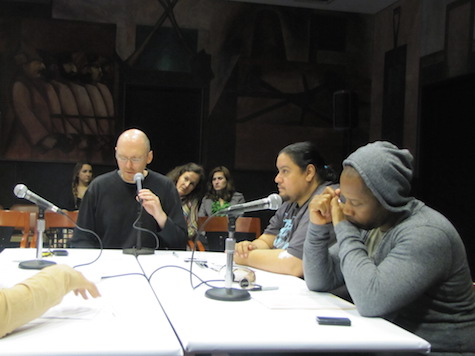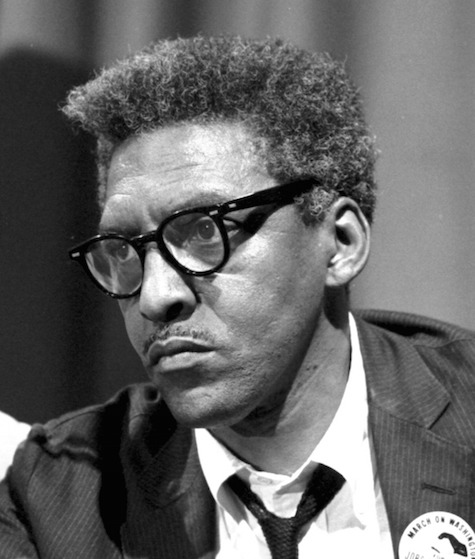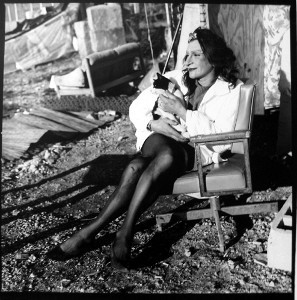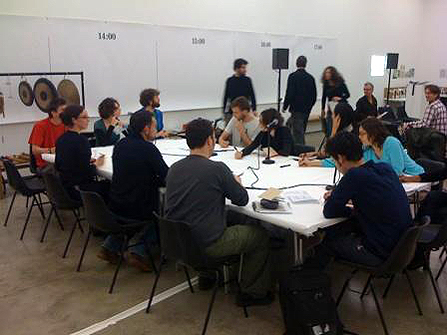Abstract
Ultra-red was founded 20 years ago by two AIDS activists and the sound art collective has grown to 12 members from the US, UK and Germany. Ultra-red focusses on issues of social justice, education and collective action within communities of marginalized peoples, the undocumented and underrepresented. In a talk at the Media@McGill: Sound Vision Action conference in fall 2014, member Dont Rhine described the collective’s shift from focussing its sound practice “from that which organizes sounds to organizes listening.” This crucial and beautiful tenet is alive within the following conversation with collective members Michael Roberson and Robert Sember.
The Cardew Object, 2009. Crédit : Ultra-red

Vogue’ology Encuentro - Robert Sember, Arbert Santan, Michael Roberson. Credit: Ultra-red
Vogue'ology listening session, Encuentro. Pictured: Robert Sember, HIV/AIDS and LGBT activist Arbert Santana and Michael Roberson. "Since the late 2000s, we have focused on the construction of sound objects to be used within the context of listening sessions i.e. we have focused on composing listening rather than composing sounds. These sound objects are not really legible outside of these listening contexts i.e. they do not function as music. When they are circulated, they accompany listening protocols and are intended to be listened to as instructional audio rather than compositions." - Robert Sember
ULTRA-RED COMING TOGETHER
.dpi: I thought we could begin very generally with background on how you both came to Ultra-red as collective members.
Robert Sember: My history with Ultra-red begins with the many years of work that I did around HIV and AIDS. This of course was also the foundation for Ultra-red's workwas within the context of the AIDS crisis. And specifically looking at issues beyond the primary constituency of the AIDS crisis, which was gay men. Both common to Ultra-red and to the work I was doing within HIV and AIDS was a focus on the needs of other communities at risk. They would have included folks who identified as LGBT or Q, but they were hopeless, incarcerated. I worked a lot with women. Incarcerated women and youth. Folks who were injecting drug users. People who were multiply diagnosed who had active addictions and mental health kinds of issues. People who are undocumented. So in many ways, the kinds of constituencies on the periphery of the periphery. I think that this is a crucial component or ethic, almost, of Ultra-red's work.
And we developed a very quick partnership that resulted in a twoyear long initiative called Silent | Listen. Which was focussed on the conditions of the AIDS crisis in the early 2000s. And it immediately and very explicitly rooted Ultra-red in what has become two very defining influences. One is popular education and the other is feminism. And the methodologies. The community organizing methodologies of feminism.
“So what does it mean for a community to be created in relationship to historical homophobia?” Michael Roberson
Michael A. Roberson: It was that work Robert and I have been collaborating on since 2001 and 2. Specifically, with Ultra Red, it began more like 2009 when Robert was artist in residence at the New School in NYC. Then we began a project with colleagues of ours and some others [...] putting the House | Ball in conversation with the reemerging gender studies program at the New School. And so we had a sound investigation called Vogue’ology.
Vogue Classique. Credit: Posted by Trrill
Since then, me and Robert have done countless numbers of events. Particularly, looking at [the] House | Ball community's ability to not only have a history that pushes past these binaries of masculinity and femininitywhat constitutes female and what constitutes malebut its history is lodged in what I call the history of Black radical struggle.
[The House | Ball community] is in conversation with feminism and womanism created through the ethos of Black woman, [which came] out of Union Theological Seminary. Its ability to, what I callinvite the problematicto create cultural and social formations allows what we call the radical pedagogy that also uses performance as a hermeneutics to tell the text, to tell a story that has kept people safe. That has mobilized people around crisis and death and catastrophe and in spite of all those things, have been resilient. So what does it mean for a community to be created in relationship to historical homophobia? Out of Black churches through the Harlem Renaissance, to realize itself across the globe? [This emerges] out of the ethos of Black trans women.
Sound composition__Sound piece 1
Credit: Ultra-red
Caption: This is "a sound composition from Silent | Listen, the project that guided Ultra-red to the School of Echoes phase of its work. This addresses the affective conditions of the AIDS crisis and is one of the last of Ultra-red's music compositions. I still find it prescient and eerily beautiful." Robert Sember
.dpi: Considering Ultra-red’s deep community engagement and the role of sound within thatI’m wondering if you might view the work of Ultra-red as a multipronged creative effort or as focussing on sound as a singular vessel for change?
Michael: One of the things I understand about sound is that the visual can compromise the sensibility. There are two reasons why I think there's soundwhat does it mean to watch bodies or what is the sound of that body? And also as a Black person, sound has always been the space of liberation for us. Through the plantation we mobilized around sound. And so we have used sound, the voice, for making music, through the drum, to be a space of liberation. BUT! And! Historically, what we have been represented as on screen has not been a space of liberation. It has always been distorted, right?
So, oftentimes why I use both sound and visual, especially when I'm doing work with the House | Ball community and marginalized Black or Latino folk, is for that same reason. So what does it mean to hear something different that goes against what you're told about what you're seeing? So, how does the Black woman body on screen say something very different than what you're told it's supposed to say? It's supposed to be a Jezebel, as Black women have been characterized throughout history on screen. It is supposed to be the theological problem. It is supposed to be the political antithetical notion of Black freedom and all this other stuff and oftentimes I'm using both sound and visual for that reason.
FQ Face Game On. Credit: jackmizrahi (Standard Youtube License)
Robert: Maybe I can say very briefly three perspectives on this issue of sound within Ultra-red.
One is in a way within Western epistemology of art. The visual has always been seen as the primary mode of knowing. A good analogy is that a lot of sound art arises out of cinema. Part of this is because we see a very close technological alignment between the apparatus for recording sound and the cinematic apparatusthese two technologies are very closely linked in the history of their emergence. And we can talk about and recognize silent film but we would never talk about cinema without image.
At the same time, if you really studied cinema, the soundtrack to film is exactly what gives it its dimension. It is in fact the immersive technology and to watch the image without the sound can greatly diminish that deep immersive identification. And so there is a way in which Ultra-red is of necessity involved in this contestation within the epistemologies of knowing. Between the visual and the aural. There's a lot to be said about that. But that's one of the things we're constantly exploring the tension around.
There is also the specific phenomenological characteristics of vision. It's very frontal, it's very objectifying. It's really the mechanism that is used for surveillance, for control, for discrimination, for judgment. The visual regime has such a deep history of power to it. So, these qualities all get evoked in this. Sound is a 360degree, 24hour medium. One can close one's eyes, you can redirect your gaze, but there is a certain immersion in sound that is a quality. It locates you. It's durational. All of these sorts of capacities become very palpable modes.
It is also, interestingly enough, an incredible mechanism for defamiliarization. When we see something, we believe automatically that we know it. And that we very quickly see the frame of the image as in fact universal. We see it as the field of knowledge. Whereas with sound that we cannot see the source of, it can become very defamiliarizing, which is one of the things about the mystery of the sound objects. It is the acousmatic. This idea that you can make a recording in one place and one time and then you can transport that sound to another place and another time.
Often it's very difficult in many instances, to be precise and clear about what it is that a sound actually is, its indexical function. What is it actually pointing towards? And so there is a new way around working with sound where you're involved in this effort, this work of decoding, in which you're trying to resolve the indexical. What is it the sound of? And at the same time you're doing that, you're having to pay attention to the qualities of the sound. Often that's the wayit's the high pitched intermittent rhythmic sound. What is that a clue of? What does it connect to? And so it evokes this sort of work. This labour. Whereas often we see in the visual, there's a sense of its immediacy. We know it. We grasp it. We can have opinions about it. And often, I find the things that we have to be very cautious around when working with image is the fact that it really triggers this immediate sense of reaction. It doesn't do what, which is what we do in Ultra Red, is slow down.
Often people get really frustrated when you slow them down and when they don't feel quite sure of where they are. But this can be a very powerful mode of things. That's one bucket of concerns that we deal with within Ultra-red.
On the other end of things, actually in one way, Ultra-red is much more interested in listening than in sound. In this sense, the visual object also can very easily become a listening object. It might not be a sound object but it can be a sound object. In the sense that as soon as you ask somebody the question, what did you see? The image is now going to be accompanied at the least by somebody's interpretations, their associations. The terms by which they make sense of it. And if you're doing this collectively, somebody listens to someone else's seeing. And this becomes the foundation for dialogue. And really this is the, if I was to say there was a core practice to Ultra-red, it's this listening dialogue relationship.
So how do we put any objectit could be being in a spacebeing in front of the screen. It can be without any prompting object, but how do you create the conditions for an intentional collective listening to each other and the dialogue that unfolds through that very deep intentional collective process of listening? And this of course, can connect with many, many issues, among them, the issues of democracy, the issues of diversity and plurality, it connects with the issues of coteaching and colearning and so on. The way in which dialogue fans into all of these really rich and absolutely necessary and empowering practices of organizing is really, really profound for us.
VOGUE’OLOGY
.dpi: Can you talk about the role of Vogue’ology, listening and the archive? How did the project come into the picture for you and Ultra-red?
Robert: Let me start off and then Michael will speak so eloquently and importantly about this because of what really we're dealing with is a history and field of experience that extends way beyond what I have encountered and lived and that Michael knows with incredible intimacy and many years of engagement. The actual Vogue'ology initiative in a way arises out of the very first encounter. It's the second encounter... This notion of the first and second encounter is very important to our thinking in Ultra-red as well, it derives from Althusser and Althusser's questions about how do we sustain political movement.
In other words, how do we have that first encounter, which is a recognition of a solidarity and struggle? How do we then have a second encounter that enables that first encounter to stick? To set in place that it becomes an organizing principle. In a way, the first encounter between Michael and myself was in 2001 when we were both in different institutions that were concerned with the issues of HIV and AIDS and all of the other kinds of structural concerns and vulnerabilities amongst young folks of colour, particularly folks who identified as lesbian, gay, bisexual, transgender, queer, and so forth. And this, with a group of people who have become critical comrades and allies in this work was a yearlong teaching and learning initiative.
Sound art piece__Sound piece 2:
I am the founder of the House of Evisu (8 May 2010)
Credit: Ultra-red
Caption: "This piece consists of a repeated statement by Arbert Santana, with whom I established the Vogue'ology project and the Ballroom Archive and Oral History Project." Robert Sember
SITAC, SILVIA RIVERA, SOLIDARITY
“...how does one imagine the sound of freedom when one is conftonted with death all the time?” Michael Roberson
Michael: To go back to this conversation around why, for me, the notion of visual in conversation with sound the a priori question is how do we listen? And why visual is utterly so important and significant? One of the things that happened for me is that me and Robert got invited to go to Mexico City to participate in SITAC in Mexico City [and] to engage in an investigation around gender justice.
There were the 43 students who disappeared after this political protest against the government, a tie, a corrupt tie with the drug cartel and a large amount of women being murdered, which they call femicides. So we were asked to come and do some sound investigations around those things so they organized some artists, some scholars and some activists. The very first day, the idea was to engage them around sound objects, which we called the sounds of freedom.
After I played them the sound objects, I asked them the very next day to bring in a sound object. For them what relates, translates, correlates to the sound of freedom. It was difficult. Because one of the things they said was freedom sounds utopian. Or eschatological. It's this place you get to that you think about that you never get to. And so, how does one imagine the sound of freedom when one is confronted with death all the time? So I said, well, there is a sound object there.
I intentionally used three visual objects and two sound objects in this notion of sounds of freedom. And, there was a very, very dense moment afterwards. And I used sound objects from what I call the Black Liberative Discourse. I used [a] Martin Luther King [on video]. And I did this beginning of documenting of Bayard Rustin And then I did a sound object of Silvia Rivera who was a Puerto Rican trans woman who was there during the Stonewall Rebellion. In 1973, she had to force herself through a mob of white gay men to be onstage to speak at the Gay Liberation Rally. And so she pushesit's almost an omen from the past that’s speaking to your future project around equality. She pushes them around their white gay middle classism that has excluded particularly poor folks in the LGBT community and specifically trans folk. So I played that.


For your eyes and ears Silvia Rivera:
And so we began that conversation. There's something about visual theological for racially marginalized folk. And that one of the things that I have witnessed is that people who are engaged in political discourse have a line of demarcation between what's political and what's theological. And I'm a believer that all politics is theological and all theology is political. It is. And so, how does one sustain a political movement? So we oftentimes ask a question with the sound objects. What did you hear? Me and Rob have added this notionnot only what did you hear but what did you see? And what did you feel?
I said to them, that to me, all political mobilization is around people wanting to feel better. I want my life to be better. That's one of the reasons why that mobilizing around my ability to survive in the hood. That's why mobilizing around not enough money allocated to Black gay men around this AIDS crisis. I want my life to feel better. That's why you see Black trans women mobilizing when Black trans women continue to be murdered. They don't want to be treated this way. And so if any political movement is going to sustain itself, if you are not engaging in what I call from an architectural level, a basic level, about what it feels to be human. It's not going to sustain itself. It's not going to sustain itself.
INVITING THE PROBLEMATIC
Robert: I wanted to just open up that phrase that Michael used, which is inviting the problematic. Because I think this is one of the extraordinary formulations. It's a political theological formulation that Michael has given us. And has given the projectthe whole Vogueology initiative and also in a sense Ultra-red. And what my understanding is, really, to acknowledge that the work of organizing, the work of consciousnessraising, the deep work of truly transformative politics, what I would also call arising out of the legacy of the Black struggle, the radical struggle, is the notion of the propheticwhich is to be able to hold simultaneously not as a contradiction!
Interestingly, [this] is a sober acknowledgement of the reality of the present oppression including the relentless violence on a daytoday basis across people and across time and generations of that violence almost to the point of a despair and hopelessness, to hold that simultaneously with the absolute certainty that freedom will come. That there in fact will be this transformative justice. And you know that the making of a new world is already begun, in a sense, through this kind of practice, this collectivity.
And in those grand scenes the Vogueology is this modest effort within those incredibly crucial, absolutely necessary, terms of political and spiritual hope and I think this is something that Michael underscores and has really brought into our workthis theological dimension which is so deeply resonant with struggles all over the world. We know this from the incredible theological terms of the anticapitalist struggle that was begun by radical Jewish intellectuals in Eastern Europe. Walter Benjamin. You know, Ernst Bloch's notion of the philosophies of the theories of hope. It is deeply implicit in Marx's analysis and Marx himself points to the prehistoric in Europe with the antiimperialist struggle, over and over and over of this issue of hope. And so this is why for me these questions around what to remember, how to remember, why to remember is so important. And then the practices around that.
BIBLIOGRAPHY
Ultra-red http://www.ultrared.org Twitter @UltraredXX
Ultra-red Public Records http://www.publicrec.org
Dont Rhine at the Media@McGill: Sound Vision Action, November 2015 webcast – “Militancy: What did you hear?” http://bcooltv.mcgill.ca/ListRecordings.aspx?CourseID=10604 Interview on Precarity Pilot http://precaritypilot.net/ultrared
Ultra-red, “Practice Sessions,” threepart video and PDF workbook http://www.welcometolace.org/pages/view/ultrared/
Deanna Radford is a cultural worker, writer and poet in Montreal. She is interested in sound art, the role of sound in poetry and the power of the people. She can be found on Twitter, here: @deannaradford.

